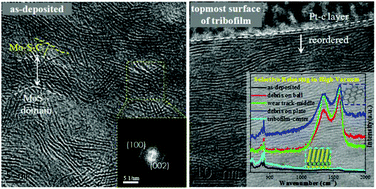Abstract: A self-assembled MoS2/Mo-S-C multilayer film prepared by r.f. co-sputtering of MoS2 and graphite targets was tribotested in diverse sliding atmospheres, and the lubricant mechanism and its correlations to the selective releasing behavior of non-lubricant component were analyzed in detail. Based on the analysis of composition and structural transformation of transferred materials by Raman and HRTEM characterizations, selective releasing behavior according to the sliding atmospheres were found to be particularly apparent in vacuum and dry inert atmospheres. Under these conditions, a-C in graphitic form was selectively released outwards from the topmost surfaces of contacts, leaving MoS2 layers finely reordered in (002) orientation playing a lubricant role. Composition and structural transformation were observed not only on the topmost surface of wear track but also on the underlying layer at a thickness of tens of nanometers. Moreover, it was found that the selective releasing of a-C initiated from the center of contacts with higher pressure, and then developed toward the edges, resulting in a gradual change in the composition and microstructure of the transferred materials from the well-aligned MoS2 layers in the center to the graphitic a-C dominant composites at the edges. The short running-in periods and low-friction performance in all the tribotests suggested that the initial preference of MoS2-riched sublayers in (002) orientation may facilitate the formation of shearless tribofilms and therefore provide a feasible way of structural tailoring in the MoS2-based lubricant films for an improved triboactive response.

KeyWords Plus: C NANOCOMPOSITE COATINGS; DEPOSITED MOS2 FILMS; TRIBOLOGICAL PROPERTIES; COMPOSITE COATINGS; AMORPHOUS-CARBON; ION-BOMBARDMENT; FRICTION; BEHAVIOR; SPECTROSCOPY; MICROSCOPY
Published in PHYSICAL CHEMISTRY CHEMICAL PHYSICS, 19 (12):8161-8173; 10.1039/c6cp08356k MAR 28 2017


